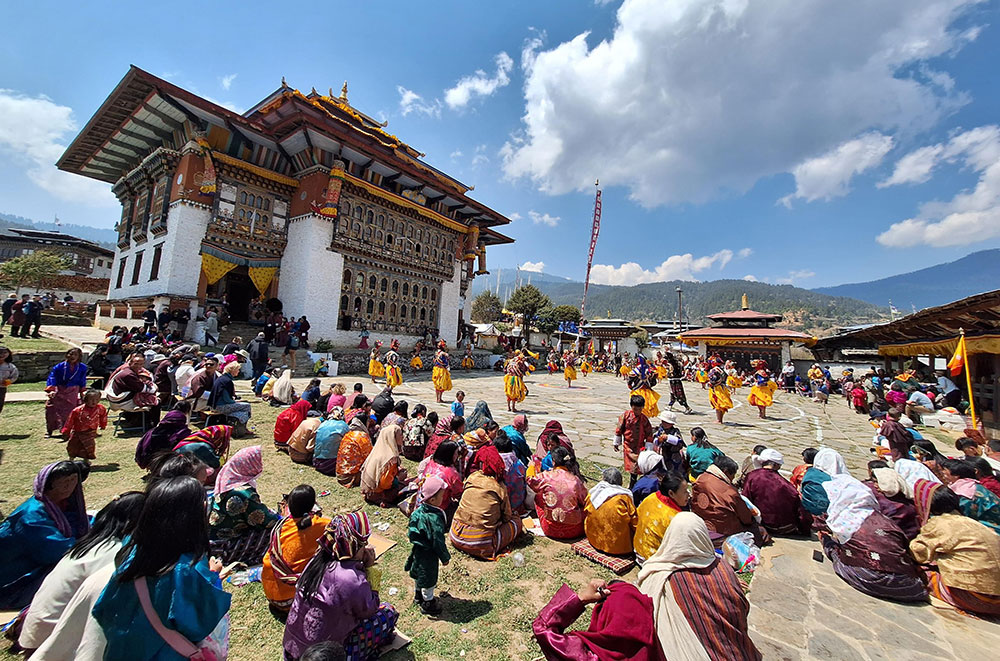Ugyen C Penjor
The village of Ura Makrong, also known as Ura Dozhi, Bumthang presents a breathtaking sight as visitors arrive. They immediately notice locked houses and halted farm work, yet locals welcome outsiders with open arms and friendly smiles. Towards the top edge of the village stands a temple, visible from afar. Inside, tourists gather to listen to a talk about the significance of the Ura Yakchod festival by Dr Karma Phuntsho.
Yakchod is the main cultural event of Ura’s social calendar. The festival is always held between the 12th and 16th days of the third Bhutanese lunar month.
The festival’s name, Yakchod, traces back to an ancient seasonal custom of offering reverence to the deity of cattle, particularly the yak god. Before the infusion of newer Buddhist practices, it is probable that villagers primarily made offerings to the pre-Buddhist cattle deities. This suggests that the festival’s essence may predate the arrival of Buddhism in the Ura valley, originating from an ancient Bon ritual.
During the five-day festival, villagers unite to celebrate life and pay homage to the gods. It is a time-honoured tradition to express gratitude to Guru Rinpoche and to commemorate the arrival of the Chagna Dorje relic.
Tshewang Dargey, 85, said about the festival’s main event. He recounted a tale from centuries past when the village faced a leprosy epidemic and turned to Guru Rinpoche for aid. It is believed that Guru Rinpoche manifested as a wandering mendicant, and a villager offered him lunch. Upon her return with food, the mendicant had vanished, leaving behind a small metal statue of Chagna Dorje in her wool container. Seeking counsel from village lamas, she was advised to enshrine it. After three days, the statue flew away to the Gedhan Temple across the valley. The affliction, villagers say, vanished with the arrival of the statue.
The festival programme and ceremony are intricately linked to the local narrative of the image’s arrival in the temple, as emphasised by another visitor, Jamayang Nidup, 86.
The festival kicks off with a procession led by the lama from the Gedhan Temple, who carries the relic to the village. The main spiritual practice of the festival is a religious ceremony that focuses on meditation on Chagna Dorje.
On the fifth and final day, the festival draws to a close with the lama and the sacred statue embarking on a tour of the village before the relic finds its resting place at a designated house. This particular house is revered as that of the woman who graciously prepared the meal for Guru Rinpoche. Chagna Dorje remains in this house for three nights, representing the duration of its initial arrival.
The main ceremony of Ura Yakchod revolves around a set of dances portraying the Chagna Dorje Mandala and associated spiritual practices. This performance is unique to the festival.
Sangay, 74, encourages the younger generation to partake in a cup of singchang, a locally brewed alcoholic drink. Local delicacies are served to all visitors. “The preparations for the festival begin nearly a month beforehand, starting with the gathering of cereals to brew singchang.
One of the festival’s highlights is the Jakor, Changkor and Tenkor rounds. In the morning, the two clowns lead the breakfast rounds, and on the final afternoon, there is a village tour with a relic and lama. During these rounds, attendees can witness various traditions, including checking the quality of the singchang, experiencing local hospitality, enjoying a robust sense of humour, and listening to unique songs and chants.
Ura is a beautiful village with farms, watermills, temples, tall towers, and colorful flags. People here live close to nature and follow old traditions. About sixty-five families live in this valley. It’s named after Ugyen Guru Rinpoche, and older folks call it Urbay, meaning the secret valley of Ugyen Rinpoche.


